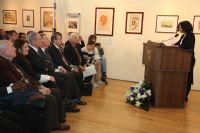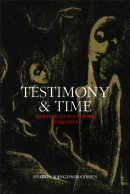| |
 |
 |
|
|
Newsletter #34, February 2015
|
 |
 |
 |
 |
 |
What's New
|
Yad Vashem Chairman Addresses UN
|
|
On January 28, 2015, the United Nations held an event marking the tenth anniversary of the International Day of Commemoration in memory of the victims of the Holocaust, as well as the 70th Anniversary of the liberation of Auschwitz-Birkenau, at the UN General Assembly. Avner Shalev, Chairman of Yad Vashem delivered the keynote address via video, “Liberty, Life and the Legacy of the Survivors.” Among those who offered remarks were UN Secretary-General Ban Ki-moon, Israel's President Reuven Rivlin; Holocaust survivor Yona Laks; and other dignitaries. Grammy award winner violinist Miri Ben-Ari also performed. Chairman Shalev's speech is available on the Yad Vashem website.
|
Traveling Exhibition Opens at UN
|
|
A new Yad Vashem Traveling Exhibition, "Shoah – How Was It Humanly Possible?" opened in the UN Visitors Lobby on January 28, 2015. United Nations Secretary-General Ban Ki-moon and the President of Israel, Reuven Rivlin, delivered remarks at the opening ceremony as well as statements by Ron Prosor, Permanent Representative of Israel to the United Nations, and Leonard Wilf, Chairman of the American Society for Yad Vashem. Created with the generous support of Cindy and Gerald Barad, the exhibition uses texts, images and video clips to recount a comprehensive history of the Holocaust from 1933-1945. The event was held in cooperation with the American Society for Yad Vashem and the Permanent Mission of Israel to the United Nations. The exhibition will remain on display at the United Nations through February 2015.
|
 |
 |
 |
 |
 |
Recent Events
|
New Display in the Museum of Holocaust Art
|

|
On January 27, 2015 a special event marking International Holocaust Remembrance Day and the 70th Anniversary of the Liberation of Auschwitz-Birkenau took place at Yad Vashem. Prime Minister Benjamin Netanyahu participated in the opening of Yad Vashem's new art exhibit, entitled "The Anguish of Liberation as Reflected in Art, 1945-1947" in the Yad Vashem Museum of Holocaust Art. The evening was held in conjunction with UNSCO, in the presence of members of the Diplomatic Corps as well as Thomas Geve, one of the survivor-artists. The display features some 30 pieces from the Yad Vashem Art Collection, produced at the time of liberation or in its immediate aftermath by 17 artists: 15 survivors, one liberator and one witness. These artworks depict the moment of liberation, as well as the devastation and loss the survivors found upon their return. Consequently, some works give voice to feelings of suffering and turmoil, while others relate to the artists’ newly found sense of freedom. A display is highlighted in a special online exhibition.
|
 |
 |
 |
 |
 |
New Publications
|
Testimony & Time
Holocaust Survivors Remember
|

|
by Sharon Kangisser Cohen, $58.00
Research on oral accounts has repeatedly argued that central to understanding an individual’s story is the context in which the telling takes place. In order to track if and how survivors’ narratives have changed and evolved over time, Testimony and Time compares their individual accounts given at different phases in their lives, in order to identify if the changing context influences and shapes survivors’ accounts of their past. The work is based on the early and later accounts of 15 survivors of the Holocaust. Early accounts were taken in the immediate post-war years and the latter interviews were conducted over 50 years later. Analysis of these interview-texts has demonstrated the remarkable resilience of Holocaust survivors’ memory of the past over time. While there is a strong continuity in memory of the core stories, this in-depth narrative study also reveals an important shift in the way survivors construct, communicate and interpret their experiences over time.
|
Letters Never Sent
Amsterdam, Westerbork, Bergen-Belsen
|
|
by Mirjam Bolle
In early 1943, Mirjam Levie, a young Jewish woman from Amsterdam, began to write letters to her fiance, Leo Bolle, who had immigrated to Eretz Israel a few years earlier. Her letters, which were never sent, were written during the deportations of the Jews from Amsterdam; her incarceration in Westerbork, a transit camp for Jewish deportees to the death camps in Poland; and her imprisonment in Bergen-Belsen. As secretary in the controversial “Jewish Council of Amsterdam”, Mirjam’s letters are the only source remaining to describe events from the viewpoint of one of its members. Mirjam was released as part of an exchange between Dutch Jews and German POWs and she arrived in Eretz Israel on 10 July 1944. This book presents a series of letters – unique in their historical interest and extremely moving in their human dimension – forming a personal diary in real time.
|
 |
 |
 |
|
|